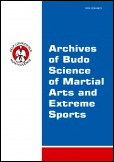2013, Volume 9, Issue 1
The interdependence of indices of efficiency, special fitness and body composition in judo athletes during the period of comprehensive training
Beata Wolska1, Władysław Jagiełło1, Valery Smulsky1, Artur Litwiniuk2
1Faculty of Physical Education, Gdańsk University of Physical Education and Sport in Gdansk, Gdansk, Poland
2Faculty of Physical Education and Sport in Biała Podlaska, Józef Piłsudski University of Physical Education in Warsaw, Biała Podlaska, Poland
Full text
Abstract
Background and Study Aim: Anaerobic and aerobic capacity belong to the most commonly used indices of performance not only in judo athletes. The study aim is the interdependence of indices of capacity (aerobic and anaerobic), special fitness and body composition in female judo athletes during the period of comprehensive training.
Material and Methods: The study involved 14 judo contestants aged 13-15 years and representing the female junior and younger junior team of Pomeranian Voivodeship in Poland. The height and body weight as well as indices characterizing the body composition were determined. To assess their aerobic capacity, the test of incremental workload until exhaustion was used, while anaerobic capacity was evaluated by means of the 30-second Wingate Test with a load on the lower limbs. The assessment of special fitness was based on the results of the Special Judo Fitness Test (SJFT). A correlation analysis between somatic indices and SJFT indices and a correlation analysis between aerobic and anaerobic capacity indices and SJFT results were also carried out.
Results: SJFT indices correlated with relative values of critical work power and with the maximum oxygen uptake. No statistically significant relationships between SJFT indices and WAnT indices were observed. A lower level of aerobic and anaerobic capacity indices as well as achievements in SJFT were noted in comparison with the results of other authors.
Conclusions: The stage of judo training significantly differentiates certain adaptive effects. Judo athletes who are in comprehensive training (initial) are inferior in special fitness and in the level of aerobic and anaerobic capacity to athletes who continue judo training at the directed and special stage.
Key words: technical preparation, special judo fitness test, long-standing sports training





